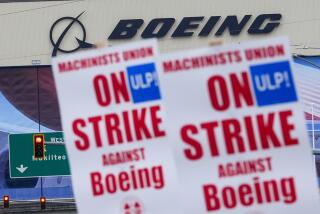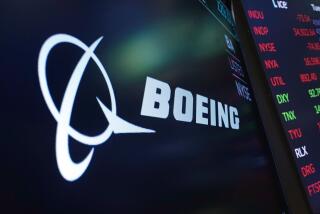Boeing’s big task: fix 787, regain trust
Marian Burkhart was looking forward to traveling on Boeing’s 787 Dreamliner. She and her husband settled into their seats, picked a movie and waited for what she called the “Taj Mahal plane” to take them from Houston to Los Angeles.
Then the pilot came on the intercom with surprising news: All passengers had to get off the plane because federal regulators had grounded the so-called aircraft of the future, concerned by fires caused by its electronics system.
Burkhart, 48, now isn’t sure whether she’ll fly on a 787.
“It’s a beautiful plane ... but I would wait awhile,” she said, moments after arriving in Los Angeles on an older airplane. “I want to make sure there aren’t any additional incidents.”
Boeing Co. is now battling on two fronts: fixing the source of the problem and regaining the trust of the flying public. This is not what the aerospace giant had planned for the 787, which the company promoted as “defining 21st century flight.”
The last time the Federal Aviation Administration grounded a large commercial jet was 36 years ago when a DC-10 crashed at Chicago O’Hare International Airport, killing all 271 aboard.
The FAA’s move to ground the Dreamliner has shaken confidence among travelers and the aviation community at large as regulators around the world took similar action against the 787.
In the latest 787 incident, smoke was seen coming from the right side of a plane belonging to Japanese carrier All Nippon Airways shortly after an emergency landing. All 137 passengers and crew members were evacuated from the aircraft and slid down the Dreamliner’s emergency slides. Video of the event was captured by an onboard passenger and has been broadcast worldwide.
“Welcome to the era of social media, Boeing,” said Michel Merluzeau, managing partner of aerospace consultant G2 Solutions in Kirkland, Wash. “That sort of thing is going to be seen by millions of people. As much as Boeing says it’s ‘teething issues’ with a new plane, they’re running out of time.”
New planes, in general, have growing pains. But the FAA’s examination into the 787’s power system is incredibly rare for a plane in service more than a year.
At issue is the Dreamliner’s electrical system and power-distribution panels, which involve pervasive use of lithium-ion batteries. The technology, also found in cellphones and electric automobiles, has a history of being involved in fires. The Dreamliner is the first large commercial aircraft to use the technology on such a large scale.
Oliver McGee, a former deputy assistant secretary at the Department of Transportation, said he believes the FAA acted appropriately in grounding the Dreamliner fleet.
“The worst thing we could have is a massive fire 30,000 feet in the air,” McGee said. “I think the grounding and improvements are essential. That said, the Boeing 787 is a safe airplane.... Any time you’re doing mass engineering you have to be patient as you take out the glitches.”
Boeing said in a statement that it believes the 787 is safe and the company is working with its airline customers and regulators to resolve the issue.
“The safety of passengers and crew members who fly aboard all Boeing airplanes is our highest priority,” Boeing said in the statement. “We are confident the 787 is safe, and we stand behind its overall integrity. Our customers are also standing behind the 787 and understand the value it brings to them and their passengers.”
Correcting the problem is only part of Boeing’s battle. It must repair the Dreamliner’s image with airlines as well as passengers.
“The longer it drags on, it obviously isn’t great for Boeing’s reputation or credibility,” said J.B. Groh, an aerospace analyst who covers Boeing for D.A. Davidson & Co. “Boeing unfortunately lives in a fish bowl, so every issue with the 787 is analyzed ad nauseam. I don’t think there’s a lot you can do to fix that.”
Boeing should be open with the public as it finds a solution, said Prashant Malaviya, a marketing professor at Georgetown University.
“In the mind of the customer, the brand has eroded already,” Malaviya said. “Fixing the real problem is not enough. The biggest thing they can do is have some transparency in the process of fixing it and then publicize that.”
Investors seemed to take the news in stride. Boeing’s stock gained 1.2% on Thursday, even as the company’s most-prized product remained on the ground.
Richard Aboulafia, an aerospace analyst with Virginia research firm Teal Group Corp., said concerns about the 787 will fade just as they did for the DC-10, which is still being used today.
“That plane recovered, and nobody really cared about traveling on it,” he said. “Boeing needs to get the problem solved, and the rest will go away.”
The Chicago company has taken 848 orders for Dreamliners from airlines and aircraft leasing firms around the world. Depending on the version ordered, the price ranges from $206.8 million to $243.6 million per jet.
At least one Boeing customer, Qantas, canceled a Dreamliner order, but said it was not related to the battery problem. The Australian airline still has 14 others on order.
The 787, a twin-aisle aircraft that can seat 210 to 290 passengers, is the first large commercial jet with more than half its structure made of composite materials (carbon fibers meshed together with epoxy) rather than aluminum sheets.
Another innovative application is that it’s the first large commercial aircraft to make the changeover from hydraulically actuated systems typically found on passenger jets to electrically powered systems involving lithium-ion batteries.
The plane is assembled at Boeing’s Everett, Wash., factory, but the bulk of the large components arrive from suppliers around the world pre-assembled. There are about 50 suppliers in California alone.
The Japanese carriers -- which own 24 of the 50 Dreamliners flying today -- decided to remove all of their 787s from service indefinitely out of safety concerns. That move led to the FAA’s extraordinary grounding order.
Jan Brueckner, an economics professor at UC Irvine who specializes in the airline industry, said he doesn’t believe the problem with the Dreamliner will severely affect the future of Boeing Co.
“The issue may be a quality control problem at the battery manufacturer, which would be easily correctable, or maybe a design problem with the component, which would take longer to correct but still not be a major setback,” he said. “Either way, this seems more like a bad version of a new-plane glitch rather than a major fault in the aircraft.”
The Chilean airline LAN, which has three Dreamliners, announced that it will temporarily ground its Boeing 787s and replace them with other aircraft.
“The safety of our operation and our passengers is our top priority, and we lament any inconvenience that this may cause,” the airline said in a statement.
Qatar Airlines, which has five Dreamliners, also announced that it has grounded its 787s.
“Our staff are assisting all affected passengers to be accommodated on other flights to get them to their final destination with minimum inconvenience,” the airline said in a statement.
Some passengers are not eager to fly on 787s, given the problems.
“If there’s some malfunction or glitches with the plane, I wouldn’t want to fly in that,” said traveler Shaunda Hamilton, who arrived in Los Angeles on a 757 on Wednesday night.
“You could just as easily choose another aircraft or another airline.... My safety means everything.”
--
william.hennigan@latimes.com
christine.maiduc@latimes.com
Times staff writer Hugo Martin contributed to this report.
More to Read
Inside the business of entertainment
The Wide Shot brings you news, analysis and insights on everything from streaming wars to production — and what it all means for the future.
You may occasionally receive promotional content from the Los Angeles Times.











